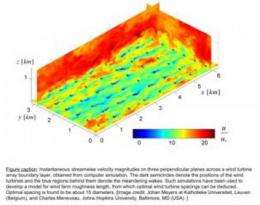Optimizing large wind farms

Wind farms around the world are large and getting larger. Arranging thousands of wind turbines across many miles of land requires new tools that can balance cost and efficiency to provide the most energy for the buck.
Charles Meneveau, who studies fluid dynamics at Johns Hopkins University, and his collaborator Johan Meyers from Leuven University in Belgium, have developed a model to calculate the optimal spacing of turbines for the very large wind farms of the future. They will present their work today at the American Physical Society Division of Fluid Dynamics (DFD) meeting in Long Beach, CA.
"The optimal spacing between individual wind turbines is actually a little farther apart than what people use these days," said Meneveau.
The blades of a turbine distort wind, creating eddies of turbulence that can affect other wind turbines farther downwind. Most previous studies have used computer models to calculate the wake effect of one individual turbine on another.
Starting with large-scale computer simulations and small-scale experiments in a wind tunnel, Meneveau's model considers the cumulative effects of hundreds or thousands of turbines interacting with the atmosphere.
"There's relatively little knowledge about what happens when you put lots of these together," said Meneveau.
The energy a large wind farm can produce, he and his coworkers discovered, depends less on horizontal winds and more on entraining strong winds from higher in the atmosphere. A 100-meter turbine in a large wind farm must harness energy drawn from the atmospheric boundary layer thousands of feet up.
In the right configuration, lots of turbines essentially change the roughness of the land -- much in the same way that trees do -- and create turbulence. Turbulence, in this case, isn't a bad thing. It mixes the air and helps to pull down kinetic energy from above.
Using as example 5 megawatt-rated machines and some reasonable economic figures, Meneveau calculates that the optimal spacing between turbines should be about 15 rotor diameters instead of the currently prevalent figure of 7 rotor diameters.
More information: The presentation, "Optimization of turbine spacing in the fully developed wind turbine array boundary layer is on Tuesday, November 23, 2010. Abstract: meetings.aps.org/Meeting/DFD10/Event/134047
Provided by American Institute of Physics















